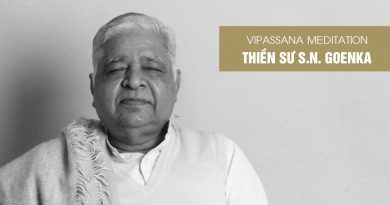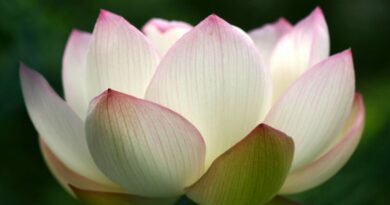Awareness Of Natural Respiration
(The following has been translated and adapted from the sixth in a series of 44 Hindi discourses given by Mr. S. N. Goenka and broadcasted on Zee TV)
The goal of Vipassana meditation is to purify the mind completely by eradicating all mental impurities such as anger, hatred, passion, fear etc. For this, one must gain complete knowledge of the body, of the mind and of the mental impurities at the experiential level, which is done with the help of respiration.
If one wants to understand one’s own physical and mental nature, one must use a pure object of concentration-natural, normal respiration. One should not try to regulate the breath or do any breathing exercise. Nor should one repeat any word or mantra or visualize any shape, form or imaginary object along with awareness of respiration. One should observe bare respiration, as it is.
When one observes respiration, one begins to understand the nature of the mind. One reality about the mind becomes very clear: the mind is very fleeting, very fickle. It wanders repeatedly from one object to another. Where does it wander? It wanders to so many objects. Even if one kept a diary, one would not be able to make a list of all the objects. But, if the meditator is attentive, he will see that the mind wanders in two areas only: either in the past or in the future. It recalls some past incident and starts to roll in thoughts of the past, “This had happened; this had not happened.” Suddenly it may jump to the future and start rolling in thoughts of the future, “This must happen; this must not happen.”
The meditator observes this present reality: he witnesses the nature of the mind objectively. Sometimes the mind wanders in the past, sometimes in the future. It never stays in the present. But one has to live in the present, not in the past. The past moment is gone forever. One cannot bring back that moment in return for all the wealth in the world. Similarly, one cannot live in the future. When the future becomes the present, only then can one live in it. So one can live neither in the past nor in the future. One has to live in the present, and yet, the mind constantly tries to escape into a past or future that is unattainable. One has not learned how to live; one has not learned the art of living.
Life can be really lived only in the present. Therefore, the first step of this technique is to develop awareness of a present reality: the breath entering or leaving the nostrils. The breath may pass through the left nostril, through the right nostril, or through both the nostrils simultaneously. One may find that after observing one or two breaths, the mind wanders away. One accepts this fact smilingly and again brings the mind back to respiration. The mind wanders again and again and one keeps returning to the awareness of respiration.
This does not mean that when one learns this technique one forgets the past completely or does not plan for the future. Oh no! After one learns the art of living in the present, one can easily recall things of the past whenever necessary and make suitable decisions about the future much more effectively.
One has to change the mind’s habit of constantly wandering in the past or in the future. One has to train the mind to remain in the present. As one continues to meditate, one recognises the tendency of the mind to constantly roll in thoughts. Of what type are these thoughts? The meditator sees that there are only two types of thoughts. Whether the mind wanders in the past or in the future, the thoughts that arise are either agreeable or disagreeable.
One is investigating the truth about oneself like a scientist, trying to understand the truth at the experiential level. One finds that whenever an agreeable thought arises in the mind about the past or the future, one feels very happy. And whenever a disagreeable thought arises in the mind about the past or the future, one feels very unhappy.
When an agreeable thought of the past or the future arises in the mind and it feels pleasant, one part of the mind starts reacting, “Oh, very good, I want more of it, I want more of it.” and this habit of “wanting, wanting” continues all the time. Similarly, we find that as soon as a disagreeable thought of the past or the future arises in the mind, a part of the mind starts reacting, “Oh, I don’t want it, I do not want it. Let this never happen.” and this habit of “not wanting, not wanting” continues all the time. In India’s ancient language, this habit of “wanting, wanting” was called rāga (craving); and the habit of “not wanting, not wanting” was called dosa (aversion). One generates these thoughts of craving and aversion continuously in the mind. Agreeable or disagreeable thoughts, either of the past or of the future, cause pleasant or unpleasant feelings and result in craving or aversion continuously.
Sometimes a thought may arise in the mind and before it is completed, another thought arises. Before that thought is completed, a third thought arises. Thoughts arise without any sequence or meaning. Such mental behaviour is commonly regarded as a sign of madness.
An example:
A plate of food is served to a mad person who has been hungry since many days. He is happy because he was very hungry. He takes a morsel but before he can eat, another thought arises in his mind-“I am in the bathroom, I have come here to have a bath and this is a cake of soap,” and he starts rubbing the food on his body. Then another thought arises-“This person standing before me is my enemy, he has come to kill me. Before he kills me, let me kill him. How can I kill him? These are hand-bombs. If I throw them at him, he will die.” So he throws all the food away. Such a person is called mad.
A discerning meditator discovers that his mind is also full of delusions, full of ignorance. In the ancient language, this was called moha(ignorance). Because of this habit of continuously generating craving, aversion or ignorance, the mind is unhappy and agitated. At the surface level of the mind, one tries to remain aware and to avoid generating craving and aversion. At times, one may feel that the surface part of the mind has become very wise and does not generate craving, aversion or ignorance any longer. But this is a very small part of the mind. The larger part of the mind, its deeper layers, is generating craving, aversion or ignorance every moment. All mental impurities arise because of the stock of these impurities in the mind. The deeper layers of the mind are unable to come out of this strong habit pattern of craving, aversion, and ignorance.
During the whole day, there may be only a few moments when one is able to cut oneself off from the past as well as the future and remain in the present. The mind is fully concentrated on respiration, the truth of the present moment. There is no delusion, no ignorance. One does not generate craving for incoming breath or aversion towards outgoing breath. One simply observes the breath entering and leaving the nostrils objectively without reacting to it. In such a moment, the mind is free from craving, aversion, and delusion; it is completely pure. This moment of purity at the conscious level has a strong impact on the old impurities accumulated in the deeper levels of the mind. The burning coals of craving, aversion and ignorance that one has accumulated within are smouldering. One has put thick layers of ash on them. “Bhasmācchanno va pāvako” The Buddha said that it is like burning coals covered by ash. It may seem that there is no fire under the layer of ash. But one is burning within because of these impurities. The contact of this internal burning with the coolness of this one moment of purity is like the contact of positive and negative forces. It produces an explosion, like the eruption of a volcano within. Some of the deep-rooted impurities may come to the surface and manifest as various physical or mental discomforts such as pain in the legs or in the head, or fear or agitation. What seems to be a problem is actually a sign of success in the meditation. When one cuts open an abscess, pus is bound to come to the surface. Similarly, the operation of the mind has started and some of the underlying pus has started to come out of the wound. Although the process is unpleasant, this is the only way to get rid of the pus, to remove the impurities. If one continues to work in the proper way, all these difficulties will gradually diminish.
When one pours a handful of water on a coal-stove to extinguish the fire, there is a reaction; there is a sound, “chung“. When cold water is poured again, there is the sound of “chung” again. The hot stove will continue to make that sound until its temperature is the same as that of the water. Once this happens, it will not make any more sound when more water is poured on it. Similarly, when drops of this cool water of mental purity fall on the burning coals of the impurities within, it produces an explosion. Because of that, the meditator will feel restless. This is another reason why one is advised to learn the technique at a meditation centre under the guidance of an experienced teacher.
If one works according to the instructions of an experienced guide at a meditation centre, one learns to be equanimous in all situations. When one learns to keep the mind balanced, the mind becomes purer and purer. The purpose of meditation is to purify the mind. The development of a pure mind results in real happiness, real peace, real harmony, real liberation.
Source: https://www.vridhamma.org







